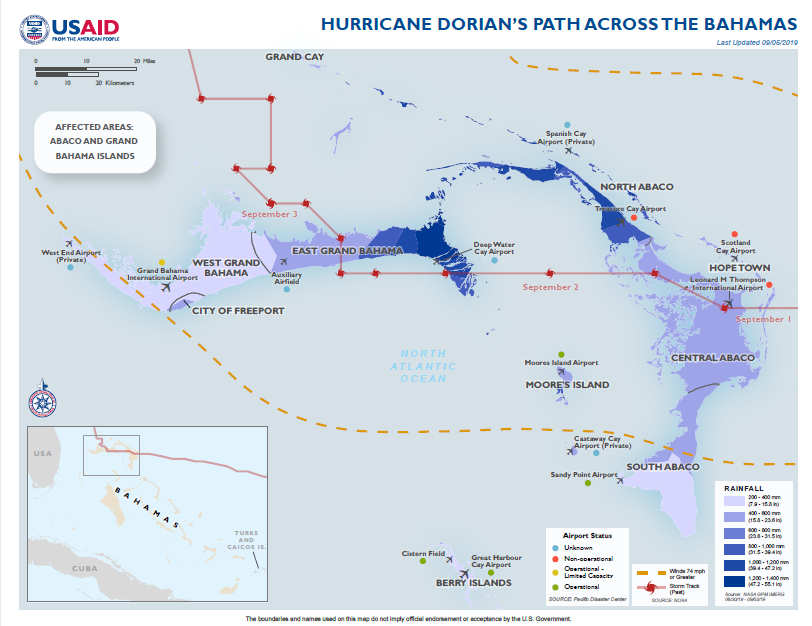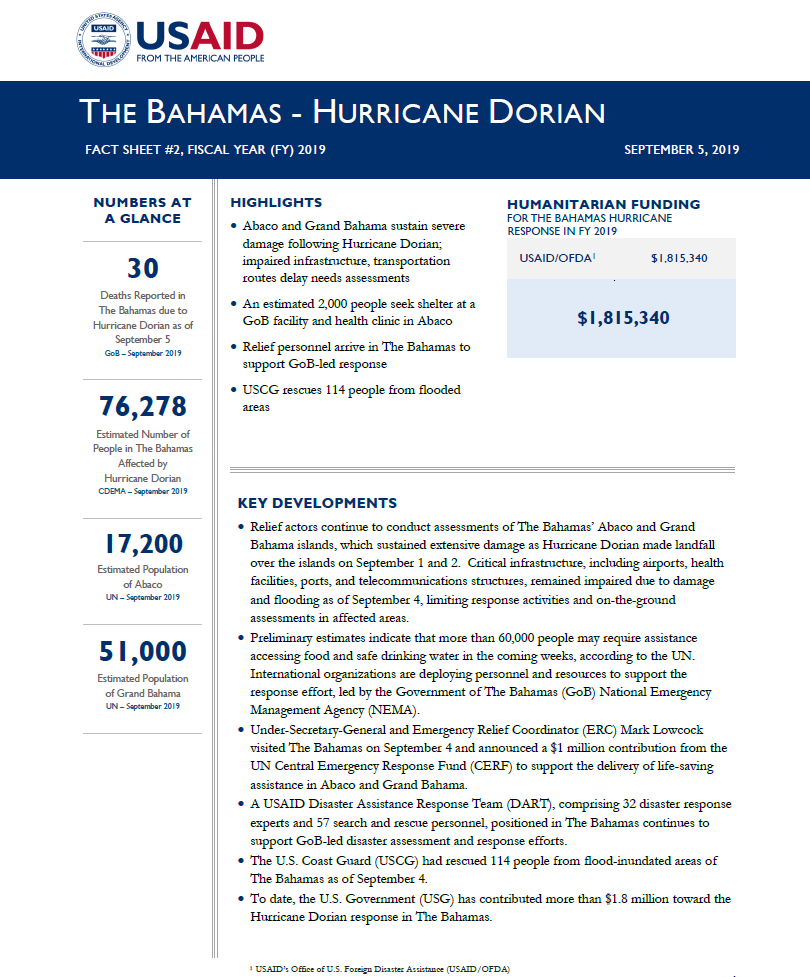- What We Do
- Agriculture and Food Security
- Democracy, Human Rights and Governance
- Economic Growth and Trade
- Education
- Environment and Global Climate Change
- Gender Equality and Women's Empowerment
- Global Health
- Humanitarian Assistance
- Transformation at USAID
- Water and Sanitation
- Working in Crises and Conflict
- U.S. Global Development Lab
Speeches Shim
September 5, 2019
Highlights
Abaco and Grand Bahama sustain severe damage following Hurricane Dorian; impaired infrastructure, transportation routes delay needs assessments
An estimated 2,000 people seek shelter at a GoB facility and health clinic in Abaco
Relief personnel arrive in The Bahamas to support GoB-led response
USCG rescues 114 people from flooded areas
The Bahamas - Hurricane Dorian Map #2, (FY) 2019 ![]() (pdf - 798k)
(pdf - 798k)
Numbers At A Glance
30
76,278
17,200
51,000
Humanitarian Funding
FOR THE BAHAMAS HURRICANE RESPONSE IN FY 2019
| USAID/OFDA | $1,815,340 |
| TOTAL | $1,815,340 |
Key Developments
Relief actors continue to conduct assessments of The Bahamas’ Abaco and Grand Bahama islands, which sustained extensive damage as Hurricane Dorian made landfall over the islands on September 1 and 2. Critical infrastructure, including airports, health facilities, ports, and telecommunications structures, remained impaired due to damage and flooding as of September 4, limiting response activities and on-the-ground assessments in affected areas.
Preliminary estimates indicate that more than 60,000 people may require assistance accessing food and safe drinking water in the coming weeks, according to the UN. International organizations are deploying personnel and resources to support the response effort, led by the Government of The Bahamas (GoB) National Emergency Management Agency (NEMA).
Under-Secretary-General and Emergency Relief Coordinator (ERC) Mark Lowcock visited The Bahamas on September 4 and announced a $1 million contribution from the UN Central Emergency Response Fund (CERF) to support the delivery of life-saving assistance in Abaco and Grand Bahama.
A USAID Disaster Assistance Response Team (DART), comprising 32 disaster response experts and 57 search and rescue personnel, positioned in The Bahamas continues to support GoB-led disaster assessment and response efforts.
The U.S. Coast Guard (USCG) had rescued 114 people from flood-inundated areas of The Bahamas as of September 4.
To date, the U.S. Government (USG) has contributed more than $1.8 million toward the Hurricane Dorian response in The Bahamas.
CURRENT SITUATION
Recent assessments indicate that Hurricane Dorian most severely affected northern Abaco, impacting an estimated 60 percent of homes in the area, according to the GoB. In Grand Bahama, the storm most heavily affected the eastern portion of the island, particularly the community of High Rock; aerial assessment teams observed blocked roads and oil spills in addition to damages to homes, buildings, and infrastructure, the UN reports. Flooding was also observed in western areas of Grand Bahama.
As of September 4, approximately 2,000 people were sheltering at a GoB compound and adjoining health clinic in Abaco’s Marsh Harbour town, according to the GoB. The GoB is working to repair a nearby school to transfer some people from the clinic, allowing it to resume normal operations.
NEMA reports that the ports in Abaco and Grand Bahama remain closed as of September 4. In addition, most telecommunication towers in Abaco remain impaired, the UN reports.
Only one airport on Abaco, Sandy Point Airport near the island’s southern end, was operational as of September 4; at least three other airports and airstrips on Abaco and nearby cays were non-operational, while the status of two others remained unknown, according to the Pacific Disaster Center (PDC). On Grand Bahama, only one airport—the Grand Bahama International Airport—had confirmed operational capacity as of September 4, though capacity is very limited; the status of three other airports on the island remained unknown.
The PDC reports that the Marsh Harbour health clinic hosting storm-affected populations was operational as of September 4; another clinic in southern Abaco’s Sandy Point town was operating at limited capacity. On Grand Bahama, the Rand Memorial Hospital was also operating with limited capacity according to the PDC, but the Pan American Health Organization noted that floodwaters remained in the hospital as of September 5. The status of more than 15 other health facilities on the islands remains unknown.
NATIONAL AND INTERNATIONAL RESPONSE
GoB authorities report sufficient resources to meet the food and water needs of affected populations for two weeks; movement of supplies to affected areas, however, is pending improved access on the islands, according to the UN. NEMA, with support from the Royal Bahamas Defence Force and international donors and response organizations, continues to lead emergency search-and-rescue and recovery efforts and the overall coordination of Hurricane Dorian response activities from its national emergency operations center in the capital city of Nassau.
The Caribbean Disaster Emergency Management Agency (CDEMA) has two Rapid Needs Assessment Teams (RNATs)—comprising representatives from the GoB, other governments from the region, and UN agencies—in Nassau; due to impaired landing sites and roads on the islands, CDEMA has postponed planned three-day assessments in Abaco and Grand Bahama, originally scheduled to begin on September 4, to September 6. In the meantime, the RNATs continue to conduct aerial assessments over Abaco and Grand Bahama.
The GoB Ministry of Health (MoH) has accepted the deployment of a U.S. non-government organization (NGO)-supported Emergency Medical Team (EMT) to Abaco; the Type 1 EMT is capable of providing mobile, outpatient emergency care for injuries and other significant health care needs. The MoH is also reviewing offers to deploy a second EMT to Grand Bahama.
ERC Lowcock visited The Bahamas on September 4 to discuss the Hurricane Dorian humanitarian situation and response efforts with relief actors and GoB officials, including Prime Minister of The Bahamas Hubert Minnis. During the visit, ERC Lowcock announced a $1 million contribution from CERF—a pooled humanitarian fund established and managed by the UN to support sudden-onset and underfunded emergencies—to support the delivery of life-saving assistance in Abaco and Grand Bahama.
The UK Department for International Development (DFID) delivered relief commodities, including shelter kits, and deployed emergency specialists to Abaco on September 4, utilizing the Royal Fleet Auxiliary (RFA) ship Mounts Bay. The UK is also supporting the GoB with aerial damage assessments through the use of the RFA Mounts Bay helicopter.
UN agencies, including the UN Office for the Coordination of Humanitarian Affairs (OCHA) and the UN World Food Program (WFP), have positioned staff in country to coordinate initial logistics activities and other response efforts.
International NGOs (INGOs) are sending teams to The Bahamas to assist with emergency response efforts. As of September 4, an 18-person team from Samaritan’s Purse had arrived to Nassau, along with 40 metric tons of relief commodities and two water desalination units. International Medical Corps is deploying a six-person response team, including a medical coordinator, mental health and psychosocial support specialists, and logistics experts, while Project Hope has deployed a team that includes an emergency response director, physician, nurse practitioner, and logistics expert. Additional INGOs, including Catholic Relief Services and Mercy Corps, are assembling teams of disaster assessment and response experts to deploy to The Bahamas in the coming days.
World Central Kitchen is transporting meals to affected communities in Abaco from its commercial kitchen in Nassau and is also working to establish an emergency kitchen in Abaco.
NetHope, Télécoms Sans Frontières, and WFP are mobilizing humanitarian telecommunications experts and satellite equipment to assist with emergency communications needs. On September 4, telecommunications organizations activated the Crisis Connectivity Charter—a mechanism that links the satellite industry with humanitarian agencies to increase the availability of satellite-based communications following a disaster. Through the Charter, emergency telecommunications organizations are exploring the possibility of utilizing data connectivity equipment in nearby Panama.
Within the U.S., Airlink, an INGO that connects the aviation industry with humanitarian organizations to transport aid and relief personnel, is helping transport INGO staff to staging areas in Florida and other U.S. states along the eastern coast in preparation for onward travel to The Bahamas.
USG RESPONSE
A USCG plane facilitated an aerial assessment of Grand Bahama on September 4 for GoB and USG officials, including members of the DART. The assessment observed minimal damage in Grand Bahama’s Freeport city, as well as traffic movement near the city. The flight did not pass over the western side of Grand Bahama; DART members plan to conduct additional assessment flights in the coming days.
USAID is shipping 250 rolls of plastic sheeting—sufficient to support shelter requirements for approximately 12,500 people—aboard five USCG Cutters to The Bahamas from USAID’s emergency warehouse in Miami, Florida. USAID/OFDA has already delivered 450 rolls of plastic sheeting to The Bahamas to support emergency shelter needs of storm-affected populations, along with other relief commodities.
The USCG also continues to support the GoB with aerial search-and-rescue operations. As of September 4, the USCG had rescued 114 people and six animals from flood-inundated areas in The Bahamas.
CONTEXT
From September 1 to 2, Hurricane Dorian made landfall over Abaco and Grand Bahama as a Category 5 storm on the Saffir-Simpson Hurricane Wind Scale, bringing sustained winds of approximately 180 miles per hour, heavy rains, and storm surges of up to 23 feet to the islands.
As a result of widespread flooding and destruction to infrastructure caused by Hurricane Dorian, U.S. Chargé d’Affaires Stephanie Bowers declared a disaster in The Bahamas on September 2. In response, USAID/OFDA provided an initial $200,000 to The Bahamas Red Cross Society and rapidly activated a DART and Response Management Team (RMT). USAID/OFDA is also coordinating with the USCG, part of the U.S. Department of Homeland Security; the U.S. Department of Defense; and the GoB to swiftly deliver emergency relief items to populations in The Bahamas most severely affected by the hurricane.
PUBLIC DONATION INFORMATION
The most effective way people can assist relief efforts is by making cash contributions to humanitarian organizations that are conducting relief operations. A list of humanitarian organizations that are accepting cash donations for disaster responses around the world can be found at www.interaction.org.
USAID encourages cash donations because they allow aid professionals to procure the exact items needed (often in the affected region); reduce the burden on scarce resources (such as transportation routes, staff time, and warehouse space); can be transferred very quickly and without transportation costs; support the economy of the disaster-stricken region; and ensure culturally, dietarily, and environmentally appropriate assistance.
More information can be found at: USAID Center for International Disaster Information: www.cidi.org/hurricane-dorian/ or +1.202.661.7710. Information on relief activities of the humanitarian community can be found at http://www.reliefweb.int.



Comment
Make a general inquiry or suggest an improvement.